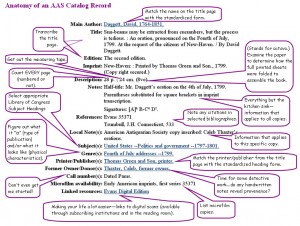People tend to treat catalog records a lot like refrigerators: open it, grab what you need, and close it up again. At AAS, the milk, eggs, and butter of the record are the author, title, and call number. Locate those three and the rest can stay a black and white blur. But know that somewhere a cataloger sheds a tear.
Cataloging to rare-book standards is an exacting process that treats the record as a surrogate for the imprint itself. The practice acknowledges the intrinsic value of each physical copy. It also recognizes the item as just one manifestation of the intellectual work as a whole. One scholar recently described using the AAS online catalog “almost every day while researching this book and years before I finally walked through the door in Worcester” because of the records’ “unparalleled annotations.” It is the goal of AAS to eventually catalog all of its pre-1877 American imprints collection to such detail. At this point, just about all American imprints through 1800 and between 1821 and 1840, and 2/3 of those between 1801 and 1820, have been so cataloged.
But what work actually goes into creating a catalog record? From a variety of sources, bibliographic and copy-specific data is collected. That information is then tailored to meet both the Anglo-American Cataloging Rules 2 (AACR2)and the Descriptive Cataloging of Rare Materials (Books) [DCRM(B)] standards. Once formatted, the metadata is inputted into the Machine Readable Cataloging (MARC) structure that creates the backbone of the online catalog.
Confused yet?
The diagram below gives you the straight scoop on what it all means. (Click on it to open an expanded version in a new window.)


Thanks for this instructive diagram. Very helpful in explaining the purpose of each part of a catalog entry. I linked to it on my blog. Hope that’s ok with you.